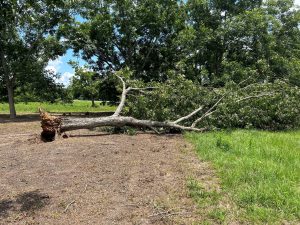Hurricane Idalia hit the Big Bend of Florida last week causing damage to a variety of crops. While some areas may have been devastated by flooding, fruit and nut trees were mainly affected by heavy winds. Usually, younger trees are more susceptible to being blown over because they have less extensive root systems. The good news is younger trees have a better chance of recovering than older trees.

A fallen pecan tree. Photo Credit: Matt Lollar, University of Florida/IFAS Extension – Santa Rosa County
–
A few things should be considered when determining if a tree can potentially be saved.
- Completely uprooted trees or trees laying on the ground should probably not be righted because of a poor survival probability.
– - Trees younger than 10 years old or with a trunk diameter less than 12 inches can potentially be saved if righted shortly after the storm. These trees should be righted soon after the storm passes before roots exposed to the air are killed.
– - A trees survival rate is higher if major roots have not been broken from uprooting.
– - Trees should be righted when soil is wet to prevent further root injury.
– - Prune back the canopy of righted trees to balance out the loss of roots.
–
Some trees may have been left leaning after the storm instead of being uprooted. Even if roots haven’t been pulled out of the ground, they may have suffered some damage. Unfortunately, long-term survival of these leaning trees is unpredictable. Some trees survive more than 20 years after being blown over to 45° angles without straightening, while others may die in a few years after slightly being blown over. If trees cannot be straightened soon after the storm, it is recommended to wait until trees are dormant to straighten. Just like with fallen trees, straightening is usually only effective on younger/smaller trees (less than 12 inches in diameter). Straightened trees usually require support from wires or frames.
Unfortunately, it costs money and requires substantial labor to help trees recover or to remove dead trees. Depending on the farm location and crop species, some farmers may be eligible to apply for the USDA’s Tree Assistance Program (TAP). This program provides financial assistance to replant or rehabilitate eligible crops lost by natural disasters. More information on this program can be found in the FSA TAP Fact Sheet. The USDA’s Farm Service Agency sometimes provides cost-share to clean up debris from a natural disaster through the Emergency Conservation Program (ECP). This funding is available, if the local FSA Committee requests and is granted approval for the program. It is important that clean-up isn’t started until damage is inspected by an FSA employee. More information on this program can be found in the FSA ECP Fact Sheet.
- Benefits of Manure Fertilizers and Analysis - March 21, 2025
- Mushrooms – A Crop Worth Consideration for the Back Forty - October 4, 2024
- Hosting an On Farm Agritourism Event: Helpful Tips - February 16, 2024
